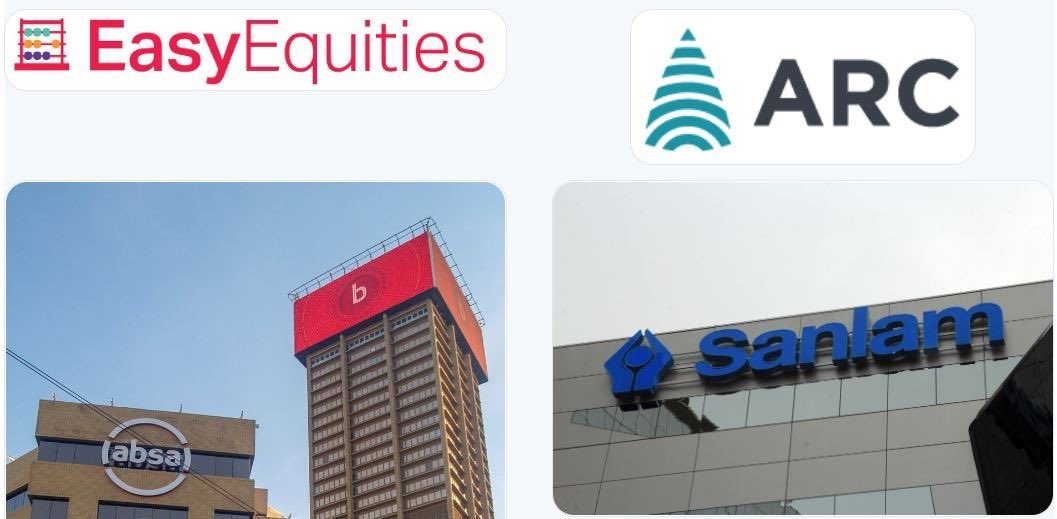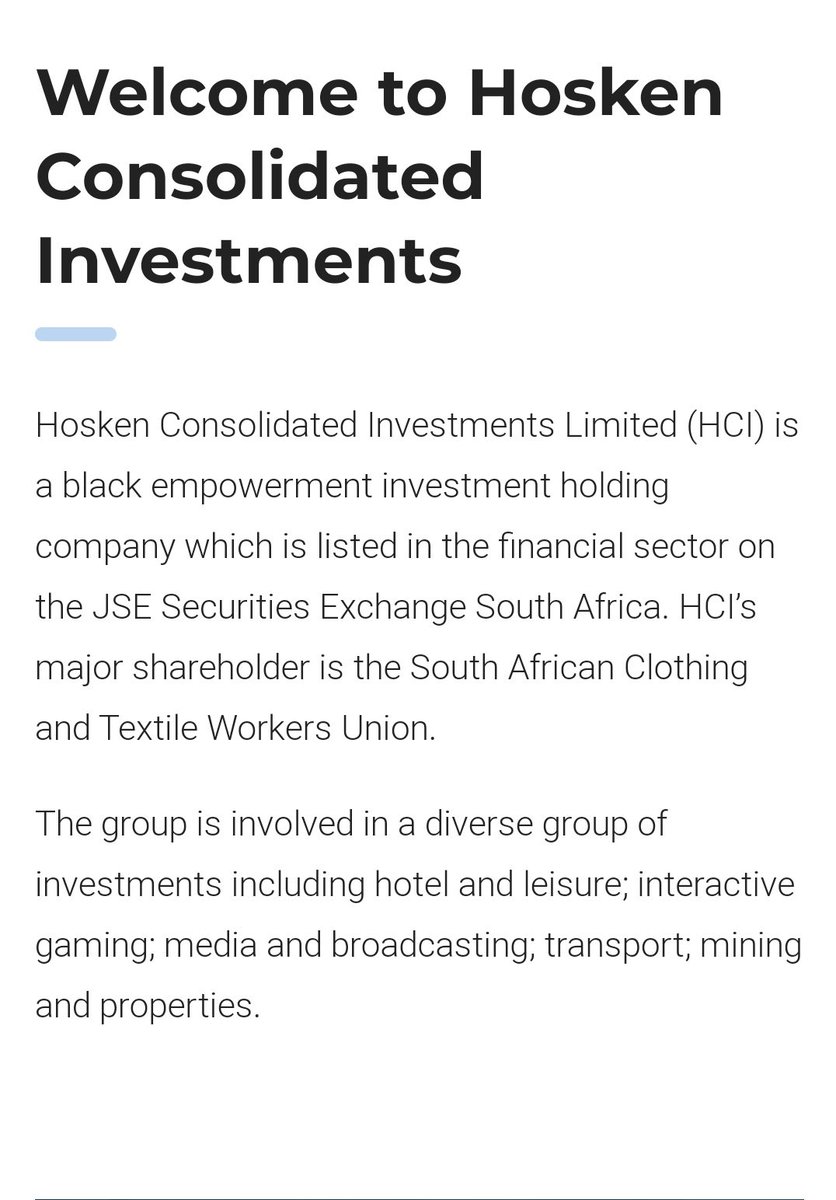
Old Mutual has received approval from the Prudential Authority to proceed with the application for a banking license.
Old Mutual once almost “owned” both Nedbank and Standard Bank at the same time.
[Thread]
Old Mutual once almost “owned” both Nedbank and Standard Bank at the same time.
[Thread]

15 Nov 1999, Nedcor announced a proposed merger offer of 1 Nedcor share for 5,5 Standard Bank shares.
The proposed offer valued Stand Bank at R29.2bn (R21.27 per share).
Minority shareholders in Standard Bank urged the then CEO Jacko Maree to make an offer to buy Nedcor.
The proposed offer valued Stand Bank at R29.2bn (R21.27 per share).
Minority shareholders in Standard Bank urged the then CEO Jacko Maree to make an offer to buy Nedcor.
Stanbic's, (biggest of the 4 large banks - Stanbic, ABSA, FirstRand and Nedcor) banking assets were valued at R184.3bn as 31 Dec 1999.
Nedcor (4th largest), had at 31 Dec 1999, assets valued at R129.8bn.
What made things interesting about this proposed merger was Old Mutual.
Nedcor (4th largest), had at 31 Dec 1999, assets valued at R129.8bn.
What made things interesting about this proposed merger was Old Mutual.
How did Old Mutual make things interesting from Nedcor's side?
Old Mutual became the major shareholder (with a 53% stake) of Nedbank Limited in 1986.
Old Mutual owned 54% of Nedcor at the time (1999) of the proposed merger.
Nedcor changed its name
to Nedbank in 2003.
Old Mutual became the major shareholder (with a 53% stake) of Nedbank Limited in 1986.
Old Mutual owned 54% of Nedcor at the time (1999) of the proposed merger.
Nedcor changed its name
to Nedbank in 2003.
How did Nedcor make things interesting from Standard Bank’s side?
Old Mutual (and it's associates) was a major shareholder in Standard bank with a 26.1% stake
So Old Mutual held;
54% of Nedcor (acquirer) and
26.1 of Standard Bank (target).
Old Mutual (and it's associates) was a major shareholder in Standard bank with a 26.1% stake
So Old Mutual held;
54% of Nedcor (acquirer) and
26.1 of Standard Bank (target).
The then Governor of the Reserve Bank Tito Mboweni said that he was concerned about the behaviour of Old Mutual, which controlled Nedcor Limited (via its 54% shareholding) and was an important shareholder in the Standard Bank Investment Corporation (with a 26.1% stake).
The two banks had the following number of employees at the time;
Standard Bank - 31000
Nedcor - 18000
There was a rumour that Nedcor wanted to reduce between 10000-15000 employees from the 49000 employees that would've comprised the combined Nedcor
Standard banking group.
Standard Bank - 31000
Nedcor - 18000
There was a rumour that Nedcor wanted to reduce between 10000-15000 employees from the 49000 employees that would've comprised the combined Nedcor
Standard banking group.
The head count at the two banks has increased since the summer of 1999.
Standard Bank has +-49 000 employees worldwide.
Nedbank has +-27 580 employees.
What role, if any, did the Competition Commission play in this proposed merger?
Standard Bank has +-49 000 employees worldwide.
Nedbank has +-27 580 employees.
What role, if any, did the Competition Commission play in this proposed merger?
The Supreme Court ruled that the Competition Commission did not have regulatory authority to approve or prohibit a bank merger.
The role of the Competition Commission was reduced to reviewing the proposed merger and making a recommendation to the Registrar of Banks.
The role of the Competition Commission was reduced to reviewing the proposed merger and making a recommendation to the Registrar of Banks.
Competition Commission proposed transaction should be prohibited due to;
a) significant social costs (abuse of
market power in the retail banking market),
b) potential job losses, which would represent a net loss to society,
c) in crease in the prices of products and services,
a) significant social costs (abuse of
market power in the retail banking market),
b) potential job losses, which would represent a net loss to society,
c) in crease in the prices of products and services,
d) a tightening of conditions for
obtaining finance,
e) a lowering of product and service quality
f) a lack of product innovation and
g) increased customer switching costs from one bank to another
Nedcor had the highest bank charges among the 4 major retail banks at the time.
obtaining finance,
e) a lowering of product and service quality
f) a lack of product innovation and
g) increased customer switching costs from one bank to another
Nedcor had the highest bank charges among the 4 major retail banks at the time.
The takeover needed to get approvals from different places such as;
Minister of Finance - Trevor Manuel (final say) and
South Africa’s Registrar of Banks - Christo Wiese.
They unanimously rejected the proposed merger.
Minister of Finance - Trevor Manuel (final say) and
South Africa’s Registrar of Banks - Christo Wiese.
They unanimously rejected the proposed merger.
How much did it cost Standard Bank to fight off Nedcor's hostile advances?
R77 million is what Standard Bank spent.
Standard Bank enlisted the services of J.P. Morgan and Deutsche Bank to act as its transaction advisors.
Nedcor contracted Warburg Dillon Read as its advisors.
R77 million is what Standard Bank spent.
Standard Bank enlisted the services of J.P. Morgan and Deutsche Bank to act as its transaction advisors.
Nedcor contracted Warburg Dillon Read as its advisors.
Had Nedbank succeed in its hostile takeover of Standard in 1999, Stanlib would've never been born.
Stanlib is currently over R500 billion in assets under management.
Stanlib is currently over R500 billion in assets under management.

STANLIB was established in 2002 following the merger of the asset management, wealth management and unit trust businesses of the Liberty Life Group and Standard Bank Group.
This resulted in STANLIB becoming the third-largest asset manager in
South Africa at the time.
This resulted in STANLIB becoming the third-largest asset manager in
South Africa at the time.
On 1 June 2003, Standard Bank and Liberty Life Group sold 25.2% (12.6% each) of STANLIB to Quantum Leap Investments 740, which was a BEE consortium.
Quantum Leap was owned
by Safika, Safika Asset Management Empowerment Trust and the Andisa BEE Trust.
Quantum Leap was owned
by Safika, Safika Asset Management Empowerment Trust and the Andisa BEE Trust.
At the end of 2006, both Quantum Leap (25.2%) and Standard Bank (37,4%) sold their stake in STANLIB.
The result was that STANLIB become a wholly-owned subsidiary of Liberty Holdings.
Standard Bank is the majority shareholder of Liberty Holdings with a 53.65% shareholding.
The result was that STANLIB become a wholly-owned subsidiary of Liberty Holdings.
Standard Bank is the majority shareholder of Liberty Holdings with a 53.65% shareholding.
October 2021, STANLIB and J.P. Morgan Asset Management (JPMAM) formed a strategic partnership.
STANLIB will have the exclusive right to distribute JPMAM’s global investment products in SA. As at 30 June 2021, J.P. Morgan Asset Management had $2.7trn assets under management.
STANLIB will have the exclusive right to distribute JPMAM’s global investment products in SA. As at 30 June 2021, J.P. Morgan Asset Management had $2.7trn assets under management.
From the 1999 hostile takeover attempt of Standard Bank by Nedcor, there were also concerns that competition would've been reduced significantly, not only on the banking front, but also in the insurance industry.
Standard Bank owned Liberty and Old Mutual (then parent of Nedcor and a very big insurance player) would've gotten Liberty as well.
Merger would've potentially killed a key distribution channel for Liberty (integrated into Old Mutual).
Standard Bank and Liberty bancassurance is the longest standing and most successful bancassurance agreement in Africa since 1991 and generated >R13bn in earnings in last 10yrs
Standard Bank and Liberty bancassurance is the longest standing and most successful bancassurance agreement in Africa since 1991 and generated >R13bn in earnings in last 10yrs

In 2021, Liberty Holdings and Standard Bank Group concluded an implementation agreement pursuant to which SBG intended to buy all the Liberty shares it currently doesn't own. SBG owned 53.62% of all issued ordinary shares in Liberty at the time.
Standard Bank Group now owns 100% of Liberty and has integrated Liberty fully into the greater group.
This is a move to resolve the balance sheet liquidity issues for Liberty.
This is a move to resolve the balance sheet liquidity issues for Liberty.
What did the selling Liberty shareholders receive on completion of the transaction?
3.5% stake in Standard Bank Group,
R1.3bn distribution from LBH (aid from Liberty’s contributed tax capital),
R1.7bn cash from SBG, and
Liberty preference shareholders receive R23m.
3.5% stake in Standard Bank Group,
R1.3bn distribution from LBH (aid from Liberty’s contributed tax capital),
R1.7bn cash from SBG, and
Liberty preference shareholders receive R23m.
This transaction created the largest financial services platform in Africa.
Standard Bank Group had R477bn assets and funds under management (AUM) while Liberty had R763bn AUM at the time the transaction was entered into.
Standard Bank Group had R477bn assets and funds under management (AUM) while Liberty had R763bn AUM at the time the transaction was entered into.
Does Old Mutual still have a big stake in Nedbank?
Nov 2021, Old Mutual decided to exit majority (12,2% of 19,4%) of its shareholding in Nedbank.
Old Mutual unbundled 12,2% Nedbank shares to Old Mutual shareholders by way of a dividend in specie in terms of the Companies Act.
Nov 2021, Old Mutual decided to exit majority (12,2% of 19,4%) of its shareholding in Nedbank.
Old Mutual unbundled 12,2% Nedbank shares to Old Mutual shareholders by way of a dividend in specie in terms of the Companies Act.
Closing fun facts:
Standard Bank's largest single shareholders are;
Industrial and Commercial Bank of China - 20.1%, and
Public Investment Corporation (PIC) - 14.2%
How did the Industrial and Commercial Bank of China get its hands on Standard Bank?
Standard Bank's largest single shareholders are;
Industrial and Commercial Bank of China - 20.1%, and
Public Investment Corporation (PIC) - 14.2%
How did the Industrial and Commercial Bank of China get its hands on Standard Bank?
Industrial and Commercial Bank of China entered into a "strategic partnership" with Standard Bank Group (SBG) and is a 20% shareholder in SBG.
ICBC paid ~R36.7-billion for a 20% stake in SBG, which surpassed the R33bn that Barclays Bank paid for a ~50% stake in Absa Bank in 2005
ICBC paid ~R36.7-billion for a 20% stake in SBG, which surpassed the R33bn that Barclays Bank paid for a ~50% stake in Absa Bank in 2005
The ball is rolling.
Old Mutual has received approval from the Prudential Authority to proceed with the application for a banking license.
Approved expenditure to complete the build of the transactional capability is R1.75bn. Old Mutual has incurred costs of R830m.
Old Mutual has received approval from the Prudential Authority to proceed with the application for a banking license.
Approved expenditure to complete the build of the transactional capability is R1.75bn. Old Mutual has incurred costs of R830m.
I always strive to make sure my threads are like a mini skirt, in that they should be long enough to cover the surfaces, but short enough to be interesting.
• • •
Missing some Tweet in this thread? You can try to
force a refresh









